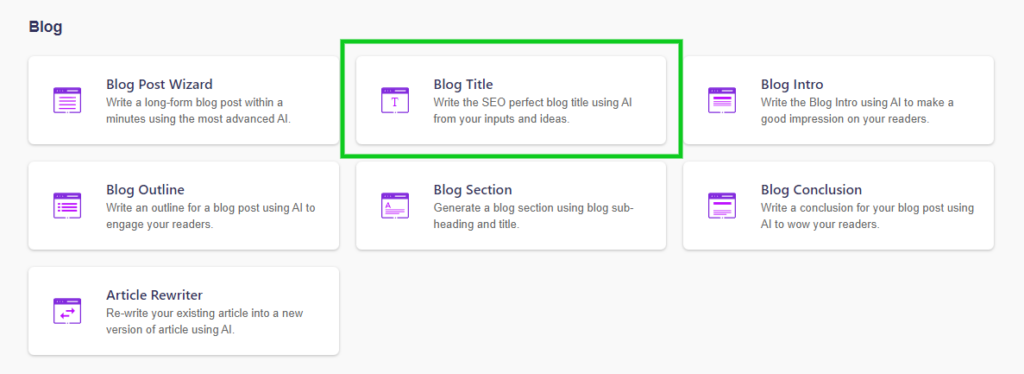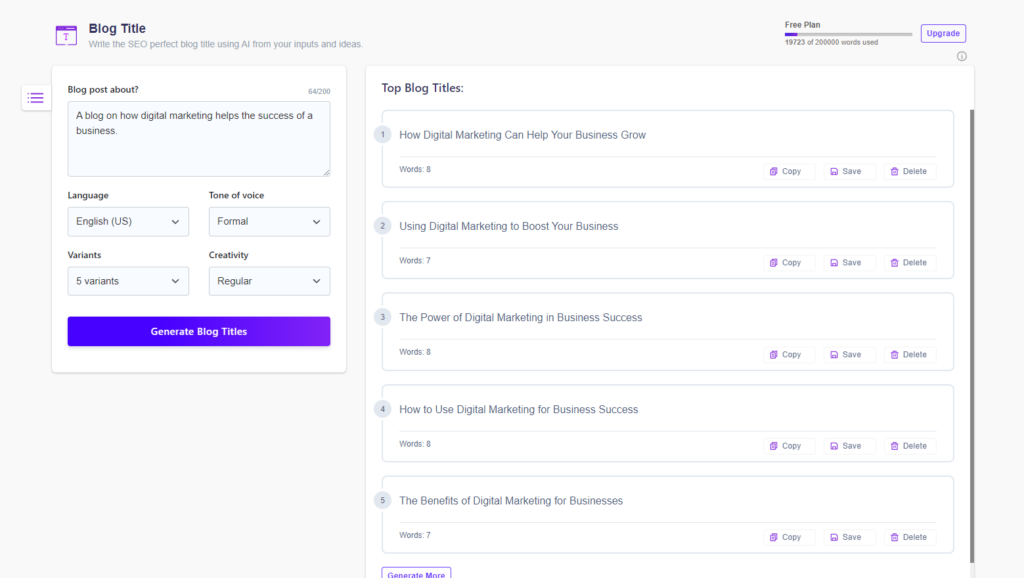If you’re running a blog or website, you know how important it is to have catchy and attention-grabbing titles. After all, your blog title is the first thing that readers will see. But coming up with creative and interesting blog titles can be hard. That’s where a Wordkraft AI’s blog title generator comes in.
A blog title generator is a tool that helps you come up with new and creative blog titles. All you need to do is enter a few keywords related to your topic, and the generator will come up with a list of potential titles.
Steps to Generate Blog Post Title Headlines
Please follow this steps to create an amazing blog post title to grab the attentions of users.
Step 1
Log-In to Wordkraft.AI app and select the Blog Title

Step 2
Now write about the blog post and select the properties

Step 3
Now Click “Generate Blog Titles” and wait for the AI to do the rest..
You will see an amazing titles generated by Wordkraft AI.

There are a number of different types of headlines that you can try out, and WordKraft AI can help you to determine which ones would be most effective for your blog post.
Different types of blog post headlines:
- Questions are a great way to engage your readers and get them thinking about your content. By asking a question in your headline, you can encourage your readers to click through to your blog post to find out the answer.
- Lists are a great way to provide readers with information in a concise and easy-to-read format. By including a list in your headline, you can let your readers know what they can expect to find in your blog post.
- How-To If you have a blog post that provides readers with information on how to do something, then including a “how-to” in your headline can be a great way to draw attention to your content. How-to headlines are also a great way to show readers that your content is informative and helpful.
- Tips Like “how-to” headlines, tips headlines are also a great way to show readers that your content is informative and helpful. By including a tips headline in your blog post, you can let your readers know that they can expect to find some helpful tips in your content.
- Advice If you have advice or recommendations to give to your readers, then including an advice headline in your blog post can be a great way to get attention to your content. By including an advice headline, you can let your readers know that your blog post contains information that they can use in their own lives. WordKraft AI can help you to come up with the perfect headline for your blog post, no matter what type of headline you want to use.
By analyzing the content of your blog post, WordKraft AI can suggest a variety of titles that would be most effective in drawing readers to your content. So if you’re looking for a way to generate the best possible titles for your blog posts, be sure to check out WordKraft AI!
Blog Post Title Generator Video Tutorial
Frequently Asked Questions about Blog Post Titles
What is a blog title?
A blog title is a short phrase or sentence that accurately and concisely describes the focus of your blog post. This title appears at the top of your blog post and is also used as the link text when your blog post is shared on social media or in an email.
A good blog title can help you draw readers to your blog, which is why it is important to choose a title that accurately reflects the content of your blog post. When it comes to SEO, your blog title is just as important as the rest of your blog post. In fact, your title is one of the first things that Google looks at when determining your ranking in search results.
How do you create a blog title?
The title of your blog post is one of the first things that people will see. It’s important to make sure that your title is catchy, interesting, and relevant to the rest of your blog post.
Here are a few tips on how to create a great blog title:
1. Keep it short and sweet. A good rule of thumb is to keep your title under 70 characters.
2. Use keywords. Including relevant keywords in your title will help your blog post rank higher in search engines.
3. Make it interesting. A catchy and interesting title will entice people to click through to your blog post.
4. Be relevant. Make sure that your title is relevant to the content of your blog post.
5. Use numbers. Lists and numbered titles are always popular and easy to read.
6. Ask a question. Asking a question in your title can be a great way to get people to read your blog post.
7. Use strong verbs. Action-oriented verbs make for great titles.
8. Use quotes. Quotes can be a great way to grab attention and make your title stand out.
What are good titles for blogs?
A good blog title is one that is catchy, interesting, and relevant to the content of the blog. A title that is too long or too short, or that is not relevant to the content, will not be effective in drawing readers to the blog. The title should be reflective of the tone of the blog – if it is a serious blog, the title should not be too jokey, and vice versa. In terms of SEO, a good title will include relevant keywords for the blog content.
How to use blog title generator?
If you’re stuck on what to name your next blog post, look no further than a Wordkraft AI blog title generator. This is a great option for generating catchy and creative titles for your blog posts. To use Wordkraft AI, simply enter the topic of your blog post and the tool will generate a list of possible titles for you to choose from. You can also specify whether you want your title to be more serious or more creative. If you’re not satisfied with the first batch of titles, simply hit the generate button again and you’ll get a new set of results. With a little bit of trial and error, you’re sure to find the perfect title for your next blog post.
How long should a blog title be?
This is a question that often comes up when people are creating blogs. There is no definitive answer, but there are some general guidelines that you can follow. The first thing to keep in mind is that a blog title should be reflective of the content of the blog. It should be concise and to the point, so that readers know what they can expect to find in the blog. In general, a blog title should be between 50-70 characters. This includes spaces, so it is important to keep that in mind when creating a title. If a title is too long, it may be cut off in search results, which can make it difficult for readers to find.
Additionally, a title that is too short may not give readers enough information about what the blog is about. A title that is just a few words long may be fine if the content of the blog is straightforward, but if it is more complex, a longer title may be necessary to give readers an idea of what they can expect. Ultimately, the best way to determine how long your blog title should be is to experiment and see what works best for you and your blog.
Level up now!
Write 10x faster, engage your audience, and ignite your writing prowess. Unleash your potential now!
No credit card required – 2000 words free per month – 146+ content types to explore